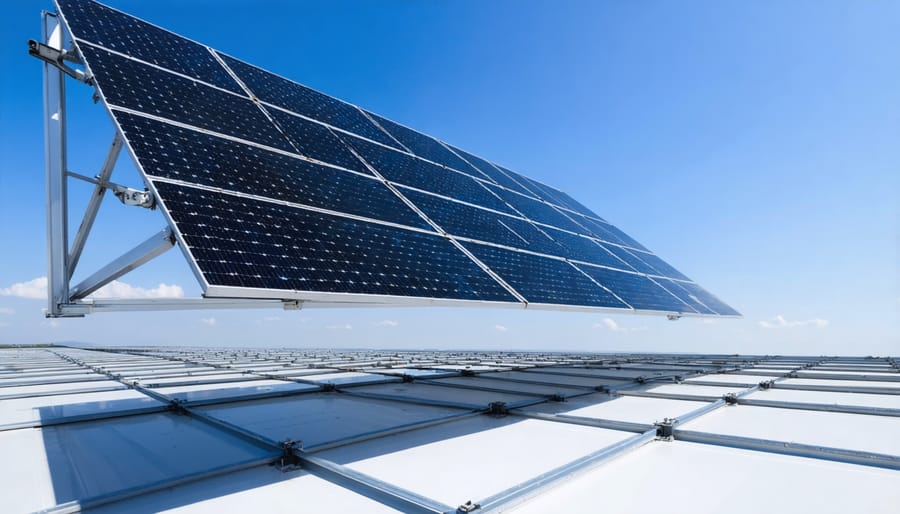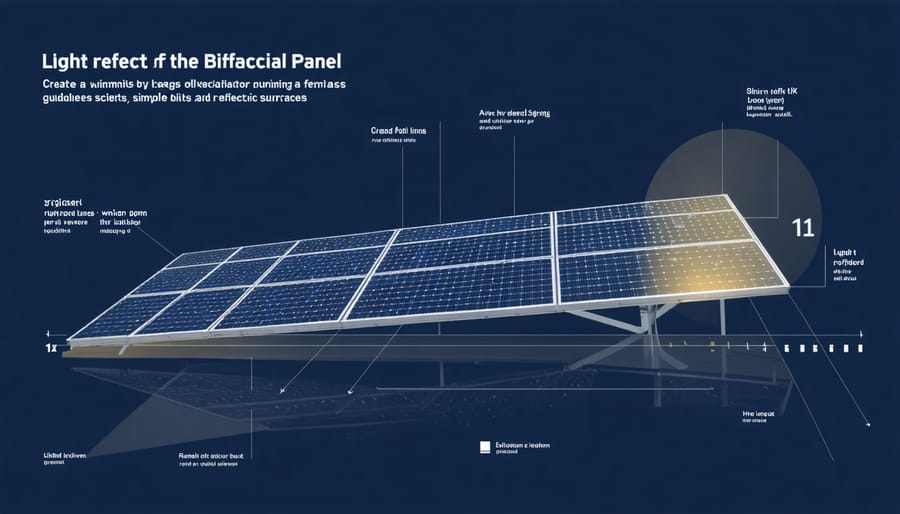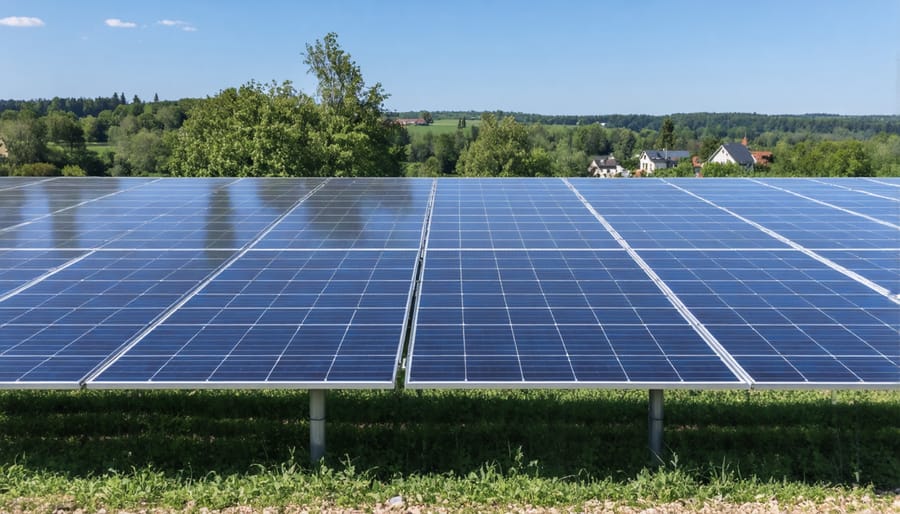Boost Your Solar Panel Output: The Game-Changing Bifacial Reflector Technology

Revolutionize solar energy harvesting with advanced reflector technology designed specifically for bifacial solar panels, capable of boosting energy yield by up to 30% compared to traditional installations. These innovative reflective surfaces, strategically positioned beneath elevated solar arrays, capture and redirect previously unused light toward the panels’ rear surface, maximizing power generation potential throughout the day. European energy markets are rapidly adopting this groundbreaking technology, as it offers an elegant solution to space constraints while delivering superior performance in both direct and diffuse lighting conditions. By combining advanced materials science with practical engineering, bifacial reflector systems represent a significant leap forward in sustainable energy technology, offering enhanced efficiency without requiring additional roof or ground space. For facility managers, developers, and homeowners seeking to optimize their solar investments, understanding the implementation and benefits of bifacial reflector technology has become increasingly crucial in achieving maximum return on investment while contributing to Europe’s renewable energy goals.
Understanding Bifacial Reflector Technology
The Science Behind Bifacial Reflection
The science behind bifacial reflection revolves around the sophisticated interplay between light physics and photovoltaic technology. When sunlight strikes a reflective surface beneath bifacial panels, it creates a secondary light source that illuminates the rear side of the solar cells. This principle, known as albedo effect, significantly enhances the panel’s overall energy capture capability.
The reflection process involves both specular (mirror-like) and diffuse reflection, depending on the surface material and texture. While specular reflection provides concentrated light beams, diffuse reflection creates a more distributed light pattern that can be particularly beneficial for consistent energy generation. The angle of reflection follows the fundamental law of reflection, where the angle of incidence equals the angle of reflection.
Modern bifacial panels typically capture between 5% and 30% additional solar energy through rear-side illumination, depending on installation height, surface reflectivity, and local conditions. The reflective surface’s efficiency is measured by its albedo coefficient, with white surfaces achieving up to 80% reflectivity compared to natural ground surfaces at 20-30%. This scientific understanding helps optimise installation parameters for maximum energy yield in European climate conditions.

Key Components and Materials
The effectiveness of bifacial solar panel reflectors relies heavily on the careful selection of materials that maximize light reflection while ensuring durability and cost-efficiency. The primary component is the reflective surface, typically constructed from highly reflective materials such as enhanced aluminum sheets, white-painted surfaces, or specialized reflective membranes with albedo ratings above 80%.
The supporting structure usually comprises weather-resistant aluminum or galvanized steel frames, designed to maintain optimal angles for light reflection while withstanding environmental stresses. These frames incorporate adjustable mounting brackets and reinforcement elements to ensure stability across varying weather conditions.
Ground cover materials play a crucial role in the system’s performance. High-quality white gravel, reflective tiles, or specialized white membrane materials are commonly used to enhance ground albedo. These materials are selected for their durability, maintenance requirements, and reflection capabilities.
Connection components, including corrosion-resistant fasteners and adjustable brackets, ensure secure installation while allowing for necessary maintenance and angle adjustments. Weather-protective elements such as UV-resistant coatings and water-resistant seals are essential for extending the system’s operational lifespan in European climate conditions.
Performance Benefits in European Installations

Energy Yield Improvements
Field studies across Europe demonstrate significant energy yield improvements when implementing bifacial solar panel reflectors. In Northern European regions like Denmark and Sweden, installations have shown production increases of 5-15% annually, with peak gains during summer months reaching up to 25%. These improvements account for various weather performance considerations specific to each location.
Central European countries, including Germany and Poland, report average yield improvements of 8-18% when using optimally positioned reflectors. The most impressive results come from installations in Southern European nations, where Spain and Italy have documented consistent production increases of 12-22% throughout the year, with some installations achieving up to 30% higher yields during peak solar hours.
These improvements vary based on installation parameters such as panel tilt angle, reflector positioning, and local environmental conditions. Alpine regions demonstrate unique benefits, with snow reflection contributing to additional energy generation during winter months, resulting in 10-20% higher annual yields compared to traditional monofacial systems.
Recent pilot projects in the Mediterranean region have shown that combining bifacial panels with specialized reflective surfaces can boost overall system efficiency by 15-25%, making it an increasingly attractive option for both commercial and residential applications.
Cost-Benefit Analysis
Installing bifacial solar panels with reflectors requires careful financial consideration, but the enhanced energy yield often justifies the initial investment. Studies across European installations show that reflector systems can increase energy production by 5-30%, depending on installation specifics and local conditions.
The additional cost for reflector materials and installation typically ranges from €40-80 per square metre, with variations based on material choice and system complexity. For a standard 10kW residential system, this translates to an extra investment of approximately €2,000-4,000. However, the increased energy generation can reduce the payback period by 1-2 years compared to traditional monofacial systems.
A typical European installation achieving a 20% boost in energy yield can generate an additional 2,000-3,000 kWh annually. At current electricity prices, this represents extra savings of €400-600 per year. When factoring in rising energy costs and available government incentives, the return on investment period typically falls between 3-5 years for the reflector component.
Maintenance costs remain minimal, with reflector cleaning required 1-2 times annually. The durability of modern reflective materials ensures a lifespan matching the solar panels themselves, typically 25+ years. When considering lifetime value, bifacial systems with reflectors demonstrate superior financial performance, offering up to 15% higher returns compared to traditional solar installations.
Installation and Maintenance Considerations
Optimal Setup Guidelines
To maximize the performance of bifacial solar panels with reflectors, careful attention must be paid to installation parameters. The key to success lies in implementing optimal mounting solutions that consider multiple factors.
First, ensure the reflective surface is positioned at a 30-45 degree angle relative to the ground, which typically delivers the best balance of reflected light capture. The distance between panels should be approximately 1.5 to 2 times the panel height to prevent unwanted shading while maximizing reflection.
The reflective material should be installed on a stable, weather-resistant structure that maintains its position throughout the year. High-quality materials like white-painted metal or specialized reflective films are recommended for durability and consistent performance.
Height optimization is crucial – panels should be mounted 1 to 1.5 meters above the reflective surface for optimal light capture. This elevation also facilitates maintenance access and natural cleaning from rainfall.
Consider the local climate and seasonal sun patterns when determining the final setup. In northern European locations, slightly steeper angles may be beneficial to capture more winter sunlight, while southern installations might benefit from shallower angles to optimize summer production.
Regular maintenance checks should be scheduled to ensure reflector cleanliness and proper positioning, as these factors directly impact system efficiency.
Long-term Maintenance Requirements
Bifacial solar panel reflectors require minimal but consistent maintenance to ensure optimal performance throughout their operational lifetime. The primary maintenance tasks include regular cleaning of reflective surfaces to remove dust, dirt, and debris that can reduce reflection efficiency. Typically, cleaning should be performed every 3-6 months, depending on local environmental conditions and pollution levels.
The reflective materials used in modern installations are designed to withstand various weather conditions and maintain their reflective properties for 15-20 years. However, annual inspections are recommended to check for any physical damage, degradation of reflective coating, or misalignment issues that might affect performance.
For ground-mounted systems, vegetation management around the reflectors is essential to prevent shadowing and maintain consistent reflection. The supporting structure should be inspected periodically for stability and corrosion, particularly in coastal areas where salt exposure can accelerate wear.
Most high-quality reflector systems come with UV-resistant coatings and anti-soiling treatments, which help extend their lifespan and reduce maintenance frequency. However, it’s advisable to schedule professional assessments every two years to ensure optimal system performance and address any potential issues proactively.
Future Developments and Innovations
Next-Generation Materials
The landscape of bifacial solar panel reflector materials is rapidly evolving, with innovative solutions emerging to enhance system performance and sustainability. Advanced polymer composites are leading the charge, offering superior durability and reflectivity while significantly reducing installation weight compared to traditional materials. These next-generation materials incorporate nano-engineered surfaces that maintain optimal reflectance even in challenging environmental conditions.
Particularly promising are self-cleaning hydrophobic coatings that minimize maintenance requirements and ensure consistent performance. These coatings, developed specifically for European weather conditions, prevent dust and debris accumulation while resisting UV degradation. Some manufacturers are also introducing smart reflective materials that can adjust their properties based on environmental conditions, optimizing energy yield throughout the day.
Biodegradable and recyclable reflector materials are gaining traction in the European market, addressing end-of-life concerns while maintaining high performance standards. Research institutions across Europe are developing composite materials that combine agricultural waste with advanced polymers, creating sustainable alternatives to conventional reflectors.
Emerging technologies include electrochromic reflectors that can dynamically alter their reflectivity and transparent photovoltaic materials that serve dual purposes as both reflectors and secondary power generators, maximizing space utilization and energy harvest potential.

Integration with Smart Solar Systems
Modern bifacial solar panel reflector systems seamlessly integrate with advanced smart monitoring systems to optimize performance and energy yield. These intelligent solutions continuously track bifacial gain, albedo measurements, and environmental conditions to ensure maximum efficiency.
Through IoT sensors and sophisticated algorithms, the system monitors both front and rear panel production, adjusting reflector positioning when necessary. Real-time data collection enables precise analysis of reflection angles, weather impact, and overall system performance, allowing for dynamic optimization of energy capture.
Integration features typically include automated cleaning schedules based on soiling detection, predictive maintenance alerts, and performance comparison across different sections of your installation. The system can identify when reflector surfaces require cleaning or when environmental factors are affecting rear-side generation efficiency.
For European installations, these smart systems are particularly valuable during winter months, when optimal reflection angles become crucial for maximizing limited sunlight. The technology also helps maintain compliance with local energy regulations by providing detailed performance documentation and efficiency reports, making it easier for businesses and homeowners to validate their renewable energy investments.
Bifacial reflector technology represents a significant leap forward in solar energy efficiency, offering a compelling solution for European businesses and homeowners seeking to maximise their renewable energy investments. By harnessing reflected light that would otherwise be lost, these systems have demonstrated potential energy yield improvements of 5-30%, depending on installation conditions and reflector configuration.
The innovation’s impact extends beyond mere performance metrics. As Europe accelerates its transition to renewable energy, bifacial reflector technology plays a crucial role in optimising limited space utilisation, particularly in urban and industrial settings. This efficiency boost helps reduce the total surface area needed for solar installations while maintaining or exceeding energy production targets.
Looking ahead, the technology shows promising development potential, with ongoing research focusing on advanced materials and optimised designs. The integration of smart monitoring systems and improved reflector durability continues to enhance the technology’s reliability and longevity, making it an increasingly attractive option for sustainable energy projects.
For the European market, bifacial reflector technology aligns perfectly with regional sustainability goals and space constraints. As installation costs continue to decrease and efficiency improvements become more refined, this technology is positioned to become a standard feature in both commercial and residential solar installations, contributing significantly to Europe’s renewable energy future.
Leave a Reply